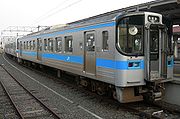JR Shikoku 7000 series
| 7000 series | |
|---|---|
 7000 series on a Sunport "Nampu" relay rapid service, May 2009 | |
| In service | November 1990– |
| Number built | 36 vehicles |
| Number in service | 36 vehicles |
| Formation | 1-3 cars per trainset |
| Operators | JR Shikoku |
| Depots | Takamatsu, Matsuyama |
| Lines served | Dosan Line, Yosan Line |
| Specifications | |
| Car body construction | Stainless steel |
| Car length | 21,300 mm (69 ft 11 in) |
| Width | 2,870 mm (9 ft 5 in) |
| Height | 3,570 mm (11 ft 9 in) |
| Doors | 3 pairs per side |
| Maximum speed | 110 km/h (70 mph) |
| Traction system | S-MT58 × 4 (Variable frequency) |
| Power output | 480 kW per car (7000 series) |
| Electric system(s) | 1,500 V DC |
| Current collector(s) | Overhead catenary |
| Bogies | S-DT58 (7000 series) S-TR58 (7100 series) |
| Safety system(s) | ATS-SS |
| Coupling system | Shibata-type |
| Multiple working | 6000 series・7200 series |
| Track gauge | 1,067 mm (3 ft 6 in) |
The 7000 series (7000系) is an electric multiple unit (EMU) train type operated by Shikoku Railway Company (JR Shikoku) in Shikoku, Japan, since November 1990.[1]
Operations
The sets are based at Takamatsu and Matsuyama depots, and operate on the Yosan Line and Dosan Line.[2] The 7000 series can operate as single-car sets, but the 7100 subseries is single-ended, and must be operated coupled with another 7000 series unit.[3] The sets are designed for use on wanman driver only operation services.[2]
Formations
As of 1 April 2012, the fleet consists of 25 7000 series motored cars and 11 7100 series trailer cars.[2]
| Designation | cMc | Tc | |
|---|---|---|---|
| Numbering | 7000 | 7100 | |
| Capacity (Total/seated) | 149/64 | 154/69 | |
| Weight (t) | 38.0 | 26.0 |
The "cMc" (7000 series) cars are fitted with one S-PS58 lozenge-type pantograph. The "Tc" (7100 series) trailer cars have no pantographs and can not operate alone.[2]
-
Double-ended car 7017 at Iyoshi Station, January 2008
-
Single-ended car 7111 at Kotohira Station, January 2008
Interior
Seating accommodation consists of longitudinal bench seating on one side and transverse seating on the other side of each car, in a similar style to the JR Shikoku 1000 series diesel units.[3]
-
Interior view of car 7018, December 2007
-
Driver's cab of car 7018, showing fare collection equipment for driver-only-operation services, December 2007
Bogies
The bogies use a bolsterless design based on the standard 205 series EMU bogies, designated S-DT58 for the motored 7000 series cars, and S-TR58 for the trailer 7100 series cars.[3]
History
The 7000 series trains were first introduced from 21 November 1990.[2]
References
- ^ Haraguchi, Takayuki (2009). Encyclopedia of JR's Railway Cars: JR全車輌. Japan: Sekai Bunka. p. 86. ISBN 978-4-418-09905-4.
- ^ a b c d e JR電車編成表 2012夏 [JR EMU Formations – Summer 2012]. Japan: JRR. May 2012. p. 205. ISBN 978-4-330-28612-9.
- ^ a b c JR全車輌ハンドブック2009 [JR Rolling Stock Handbook 2009]. Japan: Neko Publishing. 2009. p. 296. ISBN 978-4-7770-0836-0.
External links
- 7000 series information (JR Shikoku) (in Japanese)




